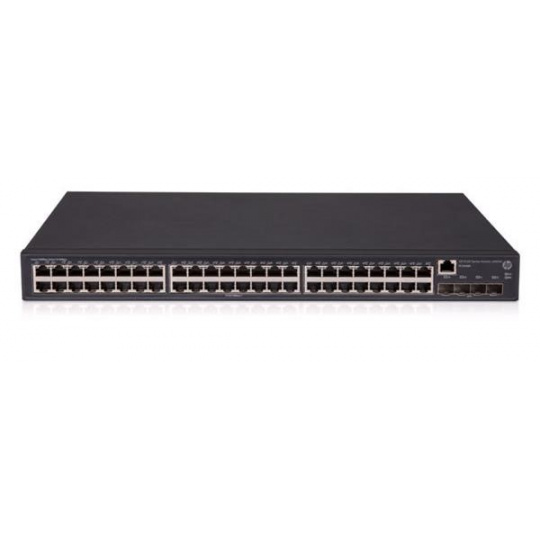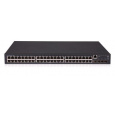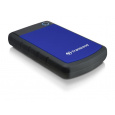HPE 5130-48G-4SFP+ EI HP RENEW Switch JG934AR
HPE 5130-48G-4SFP+ EI HP RENEW Switch JG934AR
HP 5130-48G-4SFP+ EI Switch HP RENEW
48 RJ-45 autosensing 10/100/1000 ports (IEEE 802.3 Type 10BASE-T, IEEE 802.3u Type 100BASE-TX, IEEE 802.3ab Type 1000BASE-T); Duplex: 10BASE-T/100BASE-TX: half or full; 1000BASE-T: full only
4 SFP+ fixed 1000/10000 SFP+ ports
HPE FlexNetwork 5130 48G 4SFP+ EI Switch (JG934A) Technical Specifications
HPE FlexNetwork 5130 48G 4SFP+ EI Switch (JG934A)
I/O Ports and Slots
- 48 RJ-45 autosensing 10/100/1000 ports (IEEE 802.3 Type 10BASE-T, IEEE 802.3u Type 100BASE-TX, IEEE 802.3ab Type 1000BASE-T)
- Duplex modes: 10BASE-T/100BASE-TX - half or full; 1000BASE-T - full only
- 4 SFP+ fixed 1000/10000 SFP+ ports
Additional Ports and Slots
- 1 RJ-45 serial console port
Physical Characteristics
| Dimensions (W × D × H) | 17.32 × 10.24 × 1.72 in (44 × 26 × 4.36 cm) (1U height) |
|---|---|
| Weight | 11.02 lb (5 kg) |
Memory and Processor
| Memory | 1 GB SDRAM, 512 MB flash |
|---|---|
| Packet Buffer Size | 3 MB |
Mounting and Enclosure
Mounts in an EIA standard 19-inch telco rack or equipment cabinet (hardware included)
Performance
| IPv6 Ready Certified | Yes |
|---|---|
| Latency (1000 Mb) | < 5 µs |
| Latency (10 Gbps) | < 3 µs |
| Throughput | 130.9 Mpps |
| Routing/Switching Capacity | 176 Gbps |
| Routing Table Size | 512 entries (IPv4), 256 entries (IPv6) |
| MAC Address Table Size | 16384 entries |
Environment
| Operating Temperature | 23°F to 113°F (-5°C to 45°C) |
|---|---|
| Operating Relative Humidity | 10% to 90%, noncondensing |
| Non-operating/Storage Temperature | -40°F to 158°F (-40°C to 70°C) |
| Non-operating/Storage Relative Humidity | 5% to 95%, noncondensing |
| Acoustic Noise | Low-speed fan: 38.4 dB, High-speed fan: 47.0 dB (ISO 7779) |
Electrical Characteristics
| Frequency | 50/60 Hz |
|---|---|
| Maximum Heat Dissipation | 130/153 BTU/hr (137.15/161.42 kJ/hr) AC powered units; 130-171 BTU/hr DC powered |
| Voltage | 100 - 240 VAC; -48 to -60 VDC |
| Current | 10 A |
| Maximum Power Rating | 45 W |
| Idle Power | 38 W |
Safety
UL 60950-1; EN 60825-1 & EN 60825-2; IEC 60950-1; CAN/CSA-C22.2 No. 60950-1; Anatel; ULAR; GOST; EN 60950-1/A11; FDA 21 CFR Subchapter J; NOM; ROHS Compliance
Emissions
EMC Directive 2004/108/EC; FCC (CFR 47, Part 15) Class A; EN 61000-4-11:2004; ANSI C63.4-2009; EN 61000-3-3:2008; VCCI V-4/2012.04; EN 61000-3-2:2006+A1:2009 + A2:2009; EN 61000-4-3:2006; EN 61000-4-4:2012; EN 61000-4-5:2006; EN 61000-4-6:2009; AS/NZS CISPR 22:2009 Class A; CISPR 22:2008 Class A; EN 55022:2010 Class A; EN 61000-4-29:2000; CISPR 24:2010; EN 300 386 V1.6.1; VCCI V-3/2013.04 Class A
Immunity
- Generic: EN 55024
- ESD: EN300 386
Management
- IMC
The HPE FlexNetwork 5130 EI Switch Series comprises Gigabit Ethernet switches that support static and RIP Layer 3 routing, diversified services, and IPv6 forwarding, as well as provide four 10-Gigabit Ethernet (10GbE) interfaces. Unique Intelligent Resilient Fabric (IRF) technology creates a virtual fabric by managing several switches as one logical device, which increases network resilience, performance, and availability, while reducing operational complexity. These switches provide Gigabit Ethernet access and can be used at the edge of a network or to connect server clusters in small data centers. High availability, simplified management, and comprehensive security control policies are among the key features that distinguish this series.
| HPE FlexNetwork 5130 EI Switch Series | |
| The HPE FlexNetwork 5130 EI Switch Series comprises Gigabit Ethernet switches that support static and RIP Layer 3 routing, diversified services, and IPv6 forwarding, as well as provide four 10-Gigabit Ethernet (10GbE) interfaces. Unique Intelligent Resilient Fabric (IRF) technology creates a virtual fabric by managing several switches as one logical device, which increases network resilience, performance, and availability, while reducing operational complexity. These switches provide Gigabit Ethernet access and can be used at the edge of a network or to connect server clusters in small data centers. High availability, simplified management, and comprehensive security control policies are among the key features that distinguish this series. | |
| HPE FlexNetwork 5130 24G 4SFP+ EI Switch (JG932A) | |
| HPE FlexNetwork 5130 24G SFP 4SFP+ EI Switch (JG933A) | |
| HPE FlexNetwork 5130 48G 4SFP+ EI Switch (JG934A | |
| HPE FlexNetwork 5130 24G PoE+ 4SFP+ (370W) EI Switch (JG936A) | |
| HPE FlexNetwork 5130 48G PoE+ 4SFP+ (370W) EI Switch (JG937A) | |
| HPE FlexNetwork 5130 24G POE+ 2SFP+ 2XGT (370W) EI Switch (JG940A) | |
| HPE FlexNetwork 5130 48G POE+ 2SFP+ 2XGT (370W) EI Switch (JG941A) | |
| Models | |
| HPE FlexNetwork 5130 24G 4SFP+ EI Switch | JG932A |
| HPE FlexNetwork 5130 24G SFP 4SFP+ EI Switch | JG933A |
| HPE FlexNetwork 5130 48G 4SFP+ EI Switch | JG934A |
| HPE FlexNetwork 5130 24G PoE+ 4SFP+ (370W) EI Switch | JG936A |
| HPE FlexNetwork 5130 48G PoE+ 4SFP+ (370W) EI Switch | JG937A |
| HPE FlexNetwork 5130 24G POE+ 2SFP+ 2XGT (370W) EI Switch | JG940A |
| HPE FlexNetwork 5130 48G POE+ 2SFP+ 2XGT (370W) EI Switch | JG941A |
| Key features | |
| |
Standard Features
| Features and benefits |
| Software-defined networking
|
| Quality of Service (QoS)
Classifies traffic using multiple match criteria based on Layer 2, 3, and 4 information; applies QoS policies such as setting priority level and rate limit to selected traffic on a port, VLAN, or whole switch
|
| Connectivity
Simplifies deployment and dramatically reduces installation costs by helping to eliminate the time and cost involved in supplying local power at each access point location
|
| Resiliency and high availability
Creates virtual resilient switching fabrics, where two or more switches perform as a single L2 switch and L3 router; switches do not have to be co-located and can be part of a disaster-recovery system; servers or switches can be attached using standard LACP for automatic load balancing and high availability; can eliminate the need for complex protocols like Spanning Tree Protocol, Equal-Cost Multipath (ECMP), or VRRP, thereby simplifying network operation |
| Layer 3 routing
Uses a distance vector algorithm with UDP packets for route determination; supports RIPv1 and RIPv2 routing; includes loop protection |
| Management
Leverages HWTACACS to link a custom list of CLI commands to an individual network administrator's login; also provides an audit trail
Uses standard SNMP to monitor essential network functions; supports events, alarm, history, and statistics group plus a private alarm extension group
Advertises and receives management information from adjacent devices on a network, facilitating easy mapping by network management applications
Provides scalable ASIC-based wirespeed network monitoring and accounting with no impact on network performance; this allows network operators to gather a variety of sophisticated network statistics and information for capacity planning and real-time network monitoring purposes
Mirrors ingress/egress ACL-selected traffic from a switch port or VLAN to a local or remote switch port anywhere on the network
Monitors a cable between two compatible switches and shuts down the ports on both ends if the cable is broken, which prevents network problems such as loops
Provides future-proof networking because the switch is capable of being managed whether the attached network is running IPv4 or IPv6; supports pingv6, tracertv6, Telnetv6, TFTPv6, DNSv6, syslogv6, FTPv6, SNMPv6, DHCPv6, and RADIUS for IPv6
Ingress and egress port monitoring enables network problem-solving; virtual cable tests provide visibility into cable problems
Integrates fault management, element configuration, and network monitoring from a central vantage point; built-in support for third-party devices enables network administrators to centrally manage all network elements with a variety of automated tasks, including discovery, categorization, baseline configurations, and software images; the software also provides configuration comparison tools, version tracking, change alerts, and more
SNMP v1/v2c/v3, MIB-II with Traps, and RADIUS Authentication Client MIB (RFC 2618); embedded HTML management tool with secure access |
| Security
Industry-standard method of user authentication using an IEEE 802.1X supplicant on the client in conjunction with a RADIUS server
- Per-user ACLs Permits or denies user access to specific network resources based on user identity and time of day, allowing multiple types of users on the same network to access specific network services without risking network security or providing unauthorized access to sensitive data - Automatic VLAN assignment Automatically assigns users to the appropriate VLAN based on their identities
Allows secure file transfer to and from the switch; protects against unwanted file downloads or unauthorized copying of a switch configuration file
|
| Performance
Help provide high levels of security and ease of administration without impacting network performance with a feature-rich TCAM-based ACL implementation |
| Device support
|
| Convergence
Provides up to 30 W per port that allows support of the latest PoE+-capable devices such as IP phones, wireless access points, and security cameras, as well as any IEEE 802.3af-compliant end device; eliminates the cost of additional electrical cabling and circuits that would otherwise be necessary in IP phone and WLAN deployments
Supports multiple methods (automatic, IEEE 802.3af class, LLDP-MED, or user-specified) to allocate PoE power for more efficient energy savings
|
| Additional information
Improves energy efficiency through the use of the latest advances in silicon development; shuts off unused ports and utilizes variable-speed fans, reducing energy costs
Provides an easy-to-enhance-and-extend feature set, which doesn't require whole-scale changes; all switching, routing, and security platforms leverage the Comware OS, a common unified modular operating system |
| Energy Efficient Ethernet (EEE) Support Reduces power consumption in accordance with IEEE 802.3az
|
| Layer 2 switching
Increase the scalability of an Ethernet network by providing a hierarchical structure; connect multiple LANs on a high-speed campus or metro network
Monitors link connectivity and shuts down ports at both ends if unidirectional traffic is detected, preventing loops in STP-based networks
|
| Layer 3 services
Determines the MAC address of another IP host in the same subnet; supports static ARPs; gratuitous ARP allows detection of duplicate IP addresses; proxy ARP allows normal ARP operation between subnets or when subnets are separated by a Layer 2 network
Simplifies the management of large IP networks; supports client; DHCP Relay enables DHCP operation across subnets
Allows UDP broadcasts to be directed across router interfaces to specific IP unicast or subnet broadcast addresses and prevents server spoofing for UDP services such as DHCP
|
| Warranty and support
See http://www.hpe.com/networking/warrantysummary for warranty and support information included with your product purchase.
To find software for your product, refer to http://www.hpe.com/networking/support; for details on the software releases available with your product purchase, refer to http://www.hpe.com/networking/warrantysummary |
Standards and protocols (applies to all products in series)
Device Management
RFC 1157 SNMPv1/v2c
RFC 1305 NTPv3
RFC 2573 (SNMPv3 Applications)
RFC 2819 (RMON groups Alarm, Event, History and Statistics only)
RFC 3416 (SNMP Protocol Operations v2)
HTML and telnet management
Multiple Configuration Files
SNMP v3 and RMON RFC support
SSHv1/SSHv2 Secure Shell
TACACS/TACACS+
Web UI
QoS/CoS
RFC 2474 DS Field in the IPv4 and IPv6 Headers
RFC 3260 New Terminology and Clarifications for DiffServ
General Protocols
IEEE 802.1ad Q-in-Q
IEEE 802.1ak Multiple Registration Protocol (MRP) and Multiple VLAN Registration Protocol (MVRP)
IEEE 802.1AX-2008 Link Aggregation
IEEE 802.1D MAC Bridges
IEEE 802.1p Priority
IEEE 802.1Q VLANs
IEEE 802.1s Multiple Spanning Trees
IEEE 802.1w Rapid Reconfiguration of Spanning Tree
IEEE 802.1X PAE
IEEE 802.3 Type 10BASE-T
IEEE 802.3ab 1000BASE-T
IEEE 802.3ac (VLAN Tagging Extension)
IEEE 802.3ad Link Aggregation Control Protocol (LACP)
IEEE 802.3ae 10-Gigabit Ethernet
IEEE 802.3af Power over Ethernet
IEEE 802.3at Power over Ethernet Plus
IEEE 802.3az Energy Efficient Ethernet
IEEE 802.3i 10BASE-T
IEEE 802.3u 100BASE-X
IEEE 802.3x Flow Control
IEEE 802.3z 1000BASE-X
RFC 768 UDP
RFC 783 TFTP Protocol (revision 2)
RFC 791 IP
RFC 792 ICMP
RFC 793 TCP
RFC 826 ARP
RFC 854 TELNET
RFC 855 Telnet Option Specification
RFC 894 IP over Ethernet
RFC 950 Internet Standard Subnetting Procedure
RFC 951 BOOTP
RFC 1027 Proxy ARP
RFC 1042 IP Datagrams
RFC 1071 Computing the Internet Checksum
RFC 1123 Requirements for Internet Hosts
RFC 1166 - IP Addresses
RFC 1213 Management Information Base for Network Management of TCP/IP-based internets
RFC 1256 ICMP Router Discovery Protocol (IRDP)
RFC 1305 NTPv3
RFC 1350 TFTP Protocol (revision 2)
RFC 1519 CIDR
RFC 1533 DHCP Options and BOOTP Vendor Extensions
RFC 1591 DNS (client only)
RFC 1643 - Definitions of Managed Objects for the Ethernet-like Interface Types
RFC 1812 IPv4 Routing
RFC 1866 Hypertext Markup Language - 2.0
RFC 1901 - Introduction to Community-based SNMPv2
RFC 1902-1907 - SNMPv2
RFC 2131 DHCP
RFC 2236 IGMP Snooping
RFC 2462 IPv6 Stateless Address Autoconfiguration
RFC 2474 Definition of the Differentiated Services Field (DS Field) in the IPv4 and IPv6 Headers
RFC 2475 Architecture for Differentiated Services
RFC 2597 Assured Forwarding PHB Group
RFC 2616 HTTP Compatibility v1.1
RFC 2665 Definitions of Managed Objects for the Ethernet-like Interface Types
RFC 2668 Definitions of Managed Objects for IEEE 802.3 Medium Attachment Units (MAUs)
RFC 2865 Remote Authentication Dial In User Service (RADIUS)
RFC 2866 RADIUS Accounting
RFC 3046 - DHCP Relay Agent Information Option
RFC 3246 Expedited Forwarding PHB
RFC 3414 User-based Security Model (USM) for version 3 of the Simple Network Management Protocol (SNMPv3)
RFC 3415 View-based Access Control Model (VACM) for the Simple Network Management Protocol (SNMP)
RFC 3416 Protocol Operations for SNMP
RFC 3418 Management Information Base (MIB) for the Simple Network Management Protocol (SNMP)
RFC 3576 Ext to RADIUS (CoA only)
RFC 3580 - IEEE 802.1X Remote Authentication Dial In User Service (RADIUS) Usage Guidelines
RFC 3587 IPv6 Global Unicast Address Format
RFC 3810 Multicast Listener Discovery Version 2 (MLDv2) for IPv6
RFC 4030 Authentication Suboption for DHCP Relay Agent
RFC 4213 Basic IPv6 Transition Mechanisms
RFC 4291 IP Version 6 Addressing Architecture
RFC 4541 Considerations for Internet Group Management Protocol (IGMP) and Multicast Listener Discovery (MLD) Snooping Switches
RFC 4575 A Session Initiation Protocol (SIP) Event Package for Conference State
RFC 4675 RADIUS VLAN & Priority
RFC 5095 Deprecation of Type 0 Routing Headers in IPv6
802.1r - GARP Proprietary Attribute Registration Protocol (GPRP)
IPv6
RFC 1981 IPv6 Path MTU Discovery
RFC 2460 IPv6 Specification
RFC 2461 IPv6 Neighbor Discovery
RFC 2463 ICMPv6
RFC 2464 Transmission of IPv6 over Ethernet Networks
RFC 3162 RADIUS and IPv6
RFC 3306 Unicast-Prefix-based IPv6 Multicast Addresses
RFC 3315 DHCPv6 (client and relay)
RFC 3484 Default Address Selection for IPv6
RFC 3736 Stateless Dynamic Host Configuration Protocol (DHCP) Service for IPv6
RFC 4291 IP Version 6 Addressing Architecture
RFC 4293 MIB for IP
RFC 4443 ICMPv6
RFC 4861 IPv6 Neighbor Discovery
RFC 4862 IPv6 Stateless Address Auto-configuration
RFC 6724 Default Address Selection for Internet Protocol Version 6 (IPv6)
MIBs
RFC 1212 Concise MIB Definitions
RFC 1213 MIB II
RFC 1493 Bridge MIB
RFC 1757 Remote Network Monitoring MIB
RFC 2096 IP Forwarding Table MIB
RFC 2233 Interface MIB
RFC 2571 SNMP Framework MIB
RFC 2572 SNMP-MPD MIB
RFC 2573 SNMP-Notification MIB
RFC 2573 SNMP-Target MIB
RFC 2574 SNMP USM MIB
RFC 2618 RADIUS Authentication Client MIB
RFC 2620 RADIUS Accounting Client MIB
RFC 2665 Ethernet-Like-MIB
RFC 2668 802.3 MAU MIB
RFC 2674 802.1p and IEEE 802.1Q Bridge MIB
RFC 2737 Entity MIB (Version 2)
RFC 2819 RMON MIB
RFC 2863 The Interfaces Group MIB
RFC 2925 Ping MIB
RFC 3414 SNMP-User based-SM MIB
RFC 3415 SNMP-View based-ACM MIB
RFC 3418 MIB for SNMPv3
RFC 3621 Power Ethernet MIB
IP Multicast
RFC 1112 IGMPv1
RFC 3376 IGMPv3
Network Management
IEEE 802.1AB Link Layer Discovery Protocol (LLDP)
RFC 2579 Textual Conventions for SMIv2
RFC 2580 Conformance Statements for SMIv2
RFC 2819 Four groups of RMON: 1 (statistics), 2 (history), 3 (alarm) and 9 (events)
ANSI/TIA-1057 LLDP Media Endpoint Discovery (LLDP-MED)
SNMPv1/v2c/v3
Security
IEEE 802.1X Port Based Network Access Control
RFC 1492 TACACS+
RFC 2138 RADIUS Authentication
RFC 2139 RADIUS Accounting
RFC 2865 RADIUS (client only)
RFC 2866 RADIUS Accounting
RFC 3260 New Terminology and Clarifications for DiffServ
Secure Sockets Layer (SSL)
SSHv2 Secure Shell





















